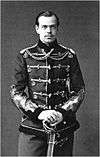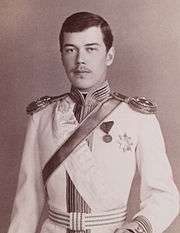Tsesarevich


Tsesarevich[1] (Russian: Цесаре́вич, IPA: [tsɨsɐˈrʲevʲɪtɕ]) was the title of the heir apparent or presumptive in the Russian Empire. It either preceded or replaced the given name and patronymic.
Usage
It is often confused with "tsarevich", which is a distinct word with a different meaning: Tsarevich was the title for any son of a tsar, including sons of non-Russian rulers accorded that title, e.g. Crimea, Siberia, Georgia.[2][3] Normally, there was only one tsesarevich at a time (an exception was Grand Duke Constantine Pavlovich, who was accorded the title until death, even though law gave it to his nephew), and the title was used exclusively in Russia.
The title came to be used invariably in tandem with the formal style "Successor" (Naslednik), as in "His Imperial Highness the Successor Tsesarevich and Grand Duke". The wife of the Tsesarevich was the Tsesarevna.[4]
History
In 1721 Peter the Great discontinued use of "tsar" as his main title, and adopted that of imperator (emperor), whereupon the title of tsarevich (and "tsarevna", retained for life by Ivan V's daughters) fell into desuetude.[2] The Emperor's daughters were henceforth referred to as "tsesarevna" (Peter had no living son by this time). In 1762, upon succeeding to the imperial throne, Peter III accorded his only son Paul Petrovich (by the future Catherine the Great) the novel title of tsesarevich, he being the first of nine Romanov heirs who would bear it.[2] However, at the time the title was conferred, Paul was recognized as Peter's legal son, but not as his legal heir. Nor would he be officially recognized as such by his mother after her usurpation of the throne.
More often he was referred to by his other title of "grand duke", which pre-dated tsesarevich, being a holdover from the Rurikid days before the grand dukes of Muscovy adopted the title of tsar. When Paul acceded to the throne in 1796, he immediately declared his son Aleksandr Pavlovich tsesarevich, and the title was confirmed by law in 1797 as the official title for the heir to the throne (incorporated into Article 145 of the Fundamental Laws).[2] Alexander I had no children: thus his brother Constantine Pavlovich became tsesarevich and, oddly, retained the title even after he renounced the throne in 1825 in favor of their younger brother, Nicholas I.[2]
Thenceforth, each Emperor's eldest son bore the title until 1894, when Nicholas II conferred it on his brother Grand Duke George Aleksandrovich, with the stipulation that his entitlement to it would terminate upon the birth of a son to Nicholas, who was then betrothed to Alix of Hesse. When George died in 1899, Nicholas did not confer the title upon his oldest surviving brother Michael Aleksandrovich, although Nicholas's only son would not be born for another five years. That son, Alexei Nikolaevich (1904-1918), became the Russian Empire's last tsesarevich.
Tsesarevich of Russia
| Picture | Name | Heir of | Birth | Became Heir to the Throne | Created Tsesarevich | Ceased to be Tsesarevich | Death | Tsesarevna |
|---|---|---|---|---|---|---|---|---|
 |
Tsesarevich Paul Petrovich later Paul I |
Peter III | 1 October 1754 | 5 January 1762 | 6 November 1796 became Emperor |
23 March 1801 | Princess Wilhelmina Louisa of Hesse-Darmstadt | |
| Catherine II | Princess Sophie Dorothea of Württemberg | |||||||
 |
Tsesarevich Alexander Pavlovich later Alexander I |
Paul I | 23 December 1777 | 17 November 1796 | 24 March 1801 became Emperor |
1 December 1825 | Princess Louise of Baden | |
.jpg) |
Tsesarevich Constantine Pavlovich | Paul I of Russia | 27 April 1779 | 24 March 1801 | 27 June 1831 | Princess Juliane of Saxe-Coburg-Saalfeld | ||
 |
Tsesarevich Alexander Nikolaevich later Alexander II |
Nicholas I | 29 April 1818 | 1 December 1825 | 2 March 1855 became Emperor |
13 March 1881 | Princess Marie of Hesse | |
 |
Tsesarevich Nicholas Alexandrovich | Alexander II | 20 September 1843 | 2 March 1855 | 24 April 1865 | |||
 |
Tsesarevich Alexander Alexandrovich later Alexander III |
10 March 1845 | 24 April 1865 | 13 March 1881 became Emperor |
1 November 1894 | Princess Dagmar of Denmark | ||
 |
Tsesarevich Nicholas Alexandrovich later Nicholas II |
Alexander III | 18 May 1868 | 13 March 1881 | 1 November 1894 became Emperor |
17 July 1918 | ||
.jpg) |
Tsesarevich George Alexandrovich | Nicholas II | 9 May 1871 | 1 November 1894 | 9 August 1899 | |||
 |
Tsesarevich Alexei Nikolaevich | 12 August 1904 | 15 March 1917 Monarchy abolished |
17 July 1918 | ||||
Tsesarevna of Russia
The wife of an heir-tsesarevich bore the title Tsesarevna (Russian: Цесаревна) - Grand Duchess. In first years of Russian Empire the female heirs of Peter I of Russia bore this title - his daughters Elizabeth of Russia (born 1709), Anna Petrovna (1708-1728) and Natalia Petrovna (1718—1725). Not to be confused with Tsarevna (used only before 18th century) for all the tsar's daughters.
Many princesses from Western Europe, who converted to Orthodox Christianity and changed their given names accordingly, were given the patronymic Fyodorovna not because their fathers were named "Theodore" but as an allegory based on the name of Theotokos of St. Theodore, the patron icon of the Romanov family.[5]
Post-Monarchy
After claiming the Russian throne in exile in 1924 Grand Duke Cyril Vladimirovich of Russia designated his son, Grand Duke Vladimir Cyrillovich of Russia, Tsesarevich.[2] Since 1997 the title has been attributed to Vladimir's grandson, George Mikhailovich Romanov, whose mother, Maria Vladimirovna, conferred it on him in her capacity as pretender to the throne.[2] Those who refer to him by a dynastic title, however, more usually address him as "grand duke".
Until the end of the empire most people in Russia and abroad, verbally and in writing continued to refer to the Sovereign as "tsar". Perhaps for that reason the title of tsesarevich was less frequently used to refer to the heir apparent than either "tsarevich" or "grand duke", particularly in less educated circles.
See also
References
- ↑ Sometimes transliterated as Cesarevich or Caesarevich
- 1 2 3 4 5 6 7 Macedonsky, Dimitry (2005 06). "Hail, Son of Caesar! A Titular History of Romanov Scions". European Royal History Journal (Arturo E. Beeche) 8.3 (XLV): 19–27. Check date values in:
|date=(help) - ↑ Burke's Royal Families of the World II. Burke's Peerage Ltd. 1980. p. 65. ISBN 0-85011-029-7.
- ↑ "Cesarevich". LoveToKnow Free Online Encyclopedia. Retrieved 2006-10-26.
- ↑ "Елисавета Феодоровна". Православная энциклопедия. Retrieved 2010-03-23.
.jpg)

.jpg)


